tire type FORD F650 2005 11.G Owners Manual
[x] Cancel search | Manufacturer: FORD, Model Year: 2005, Model line: F650, Model: FORD F650 2005 11.GPages: 272, PDF Size: 1.5 MB
Page 130 of 272
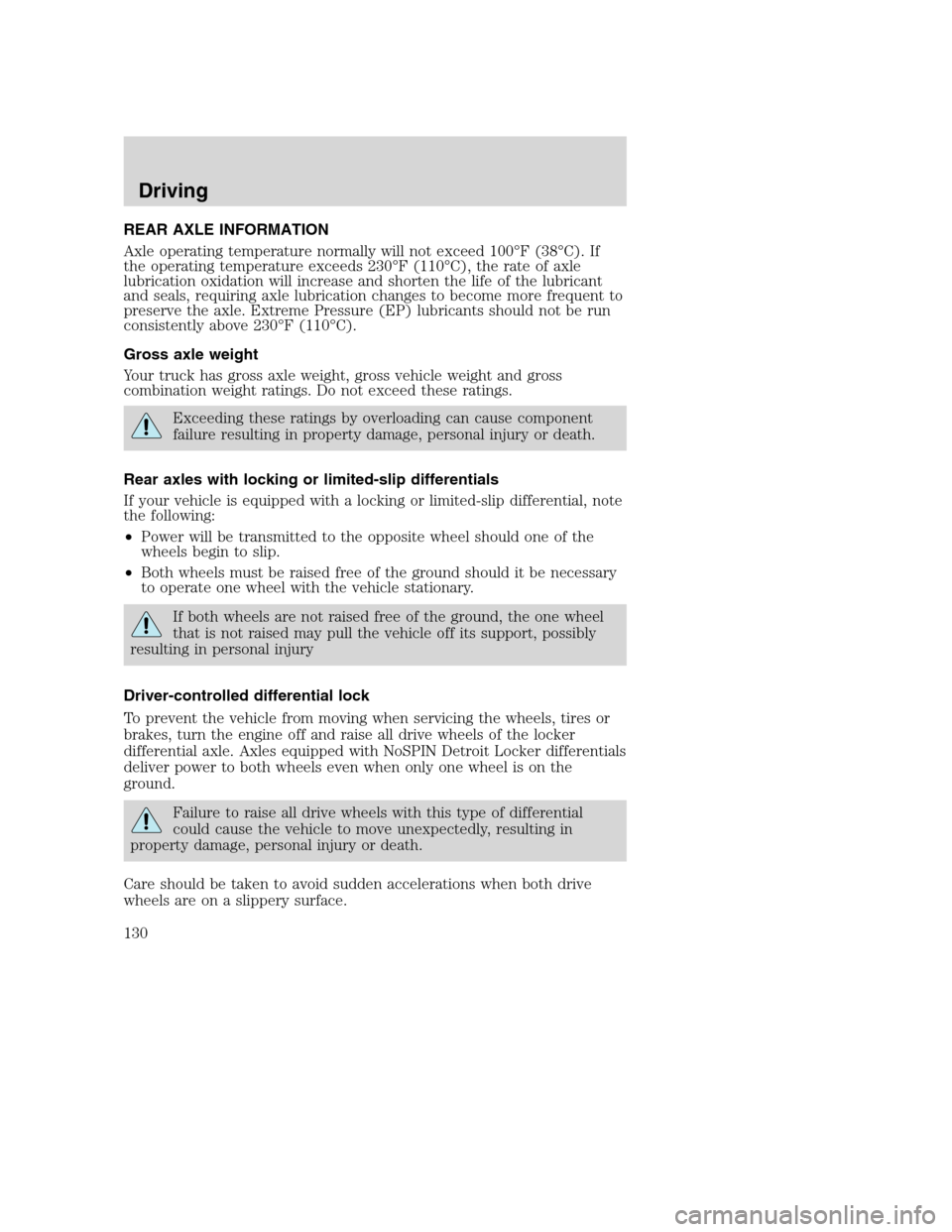
REAR AXLE INFORMATION
Axle operating temperature normally will not exceed 100°F (38°C). If
the operating temperature exceeds 230°F (110°C), the rate of axle
lubrication oxidation will increase and shorten the life of the lubricant
and seals, requiring axle lubrication changes to become more frequent to
preserve the axle. Extreme Pressure (EP) lubricants should not be run
consistently above 230°F (110°C).
Gross axle weight
Your truck has gross axle weight, gross vehicle weight and gross
combination weight ratings. Do not exceed these ratings.
Exceeding these ratings by overloading can cause component
failure resulting in property damage, personal injury or death.
Rear axles with locking or limited-slip differentials
If your vehicle is equipped with a locking or limited-slip differential, note
the following:
•Power will be transmitted to the opposite wheel should one of the
wheels begin to slip.
•Both wheels must be raised free of the ground should it be necessary
to operate one wheel with the vehicle stationary.
If both wheels are not raised free of the ground, the one wheel
that is not raised may pull the vehicle off its support, possibly
resulting in personal injury
Driver-controlled differential lock
To prevent the vehicle from moving when servicing the wheels, tires or
brakes, turn the engine off and raise all drive wheels of the locker
differential axle. Axles equipped with NoSPIN Detroit Locker differentials
deliver power to both wheels even when only one wheel is on the
ground.
Failure to raise all drive wheels with this type of differential
could cause the vehicle to move unexpectedly, resulting in
property damage, personal injury or death.
Care should be taken to avoid sudden accelerations when both drive
wheels are on a slippery surface.
Driving
130
Page 164 of 272
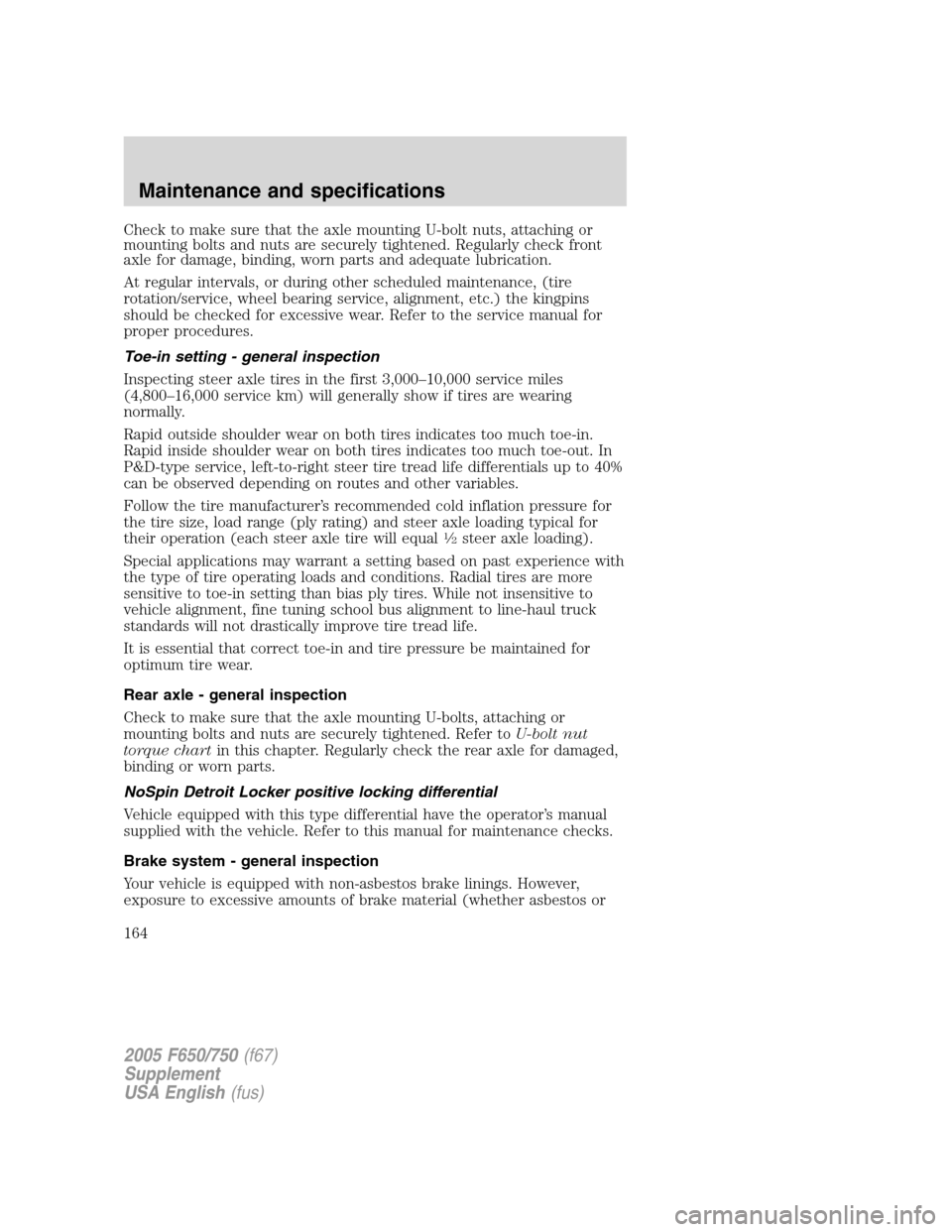
Check to make sure that the axle mounting U-bolt nuts, attaching or
mounting bolts and nuts are securely tightened. Regularly check front
axle for damage, binding, worn parts and adequate lubrication.
At regular intervals, or during other scheduled maintenance, (tire
rotation/service, wheel bearing service, alignment, etc.) the kingpins
should be checked for excessive wear. Refer to the service manual for
proper procedures.
Toe-in setting - general inspection
Inspecting steer axle tires in the first 3,000–10,000 service miles
(4,800–16,000 service km) will generally show if tires are wearing
normally.
Rapid outside shoulder wear on both tires indicates too much toe-in.
Rapid inside shoulder wear on both tires indicates too much toe-out. In
P&D-type service, left-to-right steer tire tread life differentials up to 40%
can be observed depending on routes and other variables.
Follow the tire manufacturer’s recommended cold inflation pressure for
the tire size, load range (ply rating) and steer axle loading typical for
their operation (each steer axle tire will equal
1⁄2steer axle loading).
Special applications may warrant a setting based on past experience with
the type of tire operating loads and conditions. Radial tires are more
sensitive to toe-in setting than bias ply tires. While not insensitive to
vehicle alignment, fine tuning school bus alignment to line-haul truck
standards will not drastically improve tire tread life.
It is essential that correct toe-in and tire pressure be maintained for
optimum tire wear.
Rear axle - general inspection
Check to make sure that the axle mounting U-bolts, attaching or
mounting bolts and nuts are securely tightened. Refer toU-bolt nut
torque chartin this chapter. Regularly check the rear axle for damaged,
binding or worn parts.
NoSpin Detroit Locker positive locking differential
Vehicle equipped with this type differential have the operator’s manual
supplied with the vehicle. Refer to this manual for maintenance checks.
Brake system - general inspection
Your vehicle is equipped with non-asbestos brake linings. However,
exposure to excessive amounts of brake material (whether asbestos or
2005 F650/750(f67)
Supplement
USA English(fus)
Maintenance and specifications
164
Page 166 of 272
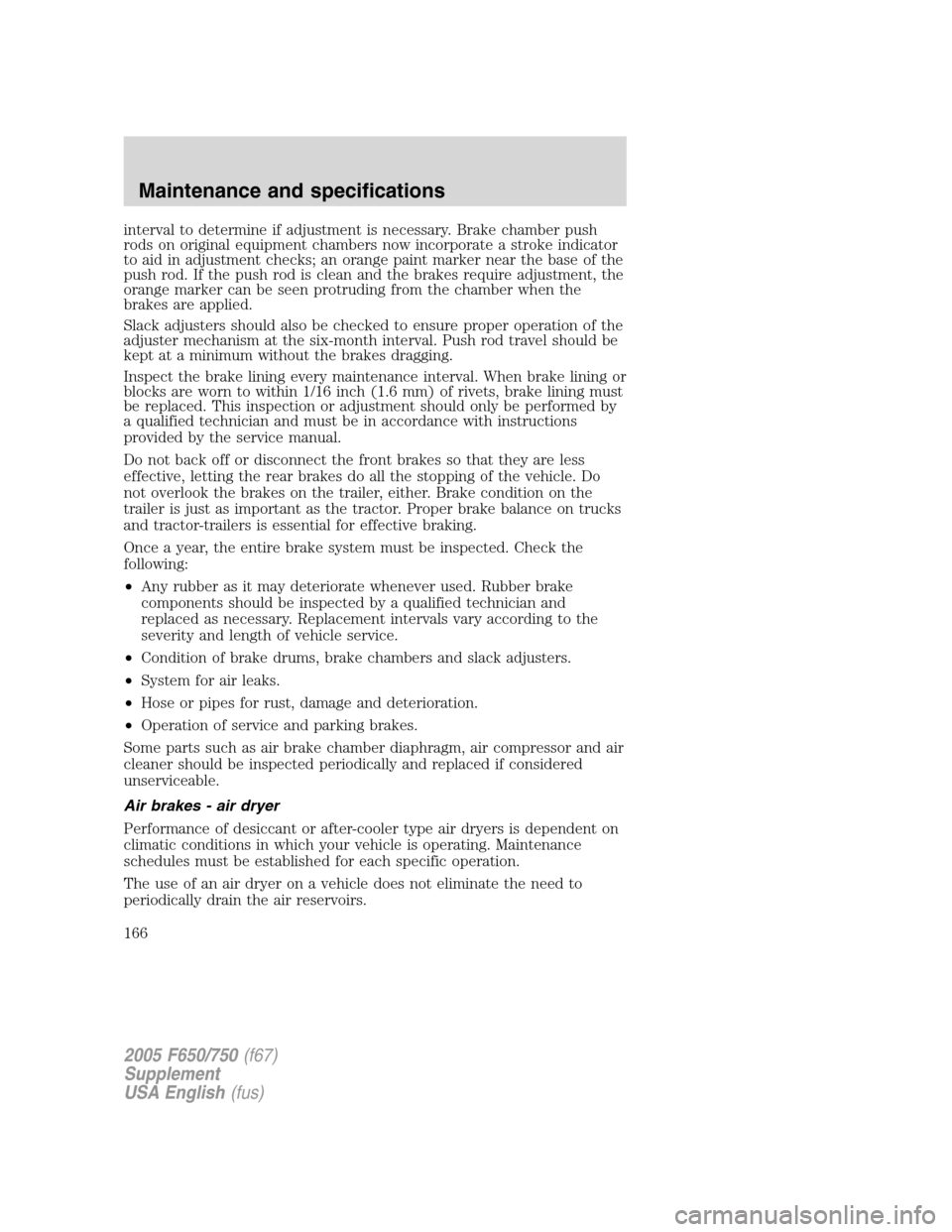
interval to determine if adjustment is necessary. Brake chamber push
rods on original equipment chambers now incorporate a stroke indicator
to aid in adjustment checks; an orange paint marker near the base of the
push rod. If the push rod is clean and the brakes require adjustment, the
orange marker can be seen protruding from the chamber when the
brakes are applied.
Slack adjusters should also be checked to ensure proper operation of the
adjuster mechanism at the six-month interval. Push rod travel should be
kept at a minimum without the brakes dragging.
Inspect the brake lining every maintenance interval. When brake lining or
blocks are worn to within 1/16 inch (1.6 mm) of rivets, brake lining must
be replaced. This inspection or adjustment should only be performed by
a qualified technician and must be in accordance with instructions
provided by the service manual.
Do not back off or disconnect the front brakes so that they are less
effective, letting the rear brakes do all the stopping of the vehicle. Do
not overlook the brakes on the trailer, either. Brake condition on the
trailer is just as important as the tractor. Proper brake balance on trucks
and tractor-trailers is essential for effective braking.
Once a year, the entire brake system must be inspected. Check the
following:
•Any rubber as it may deteriorate whenever used. Rubber brake
components should be inspected by a qualified technician and
replaced as necessary. Replacement intervals vary according to the
severity and length of vehicle service.
•Condition of brake drums, brake chambers and slack adjusters.
•System for air leaks.
•Hose or pipes for rust, damage and deterioration.
•Operation of service and parking brakes.
Some parts such as air brake chamber diaphragm, air compressor and air
cleaner should be inspected periodically and replaced if considered
unserviceable.
Air brakes - air dryer
Performance of desiccant or after-cooler type air dryers is dependent on
climatic conditions in which your vehicle is operating. Maintenance
schedules must be established for each specific operation.
The use of an air dryer on a vehicle does not eliminate the need to
periodically drain the air reservoirs.
2005 F650/750(f67)
Supplement
USA English(fus)
Maintenance and specifications
166
Page 209 of 272
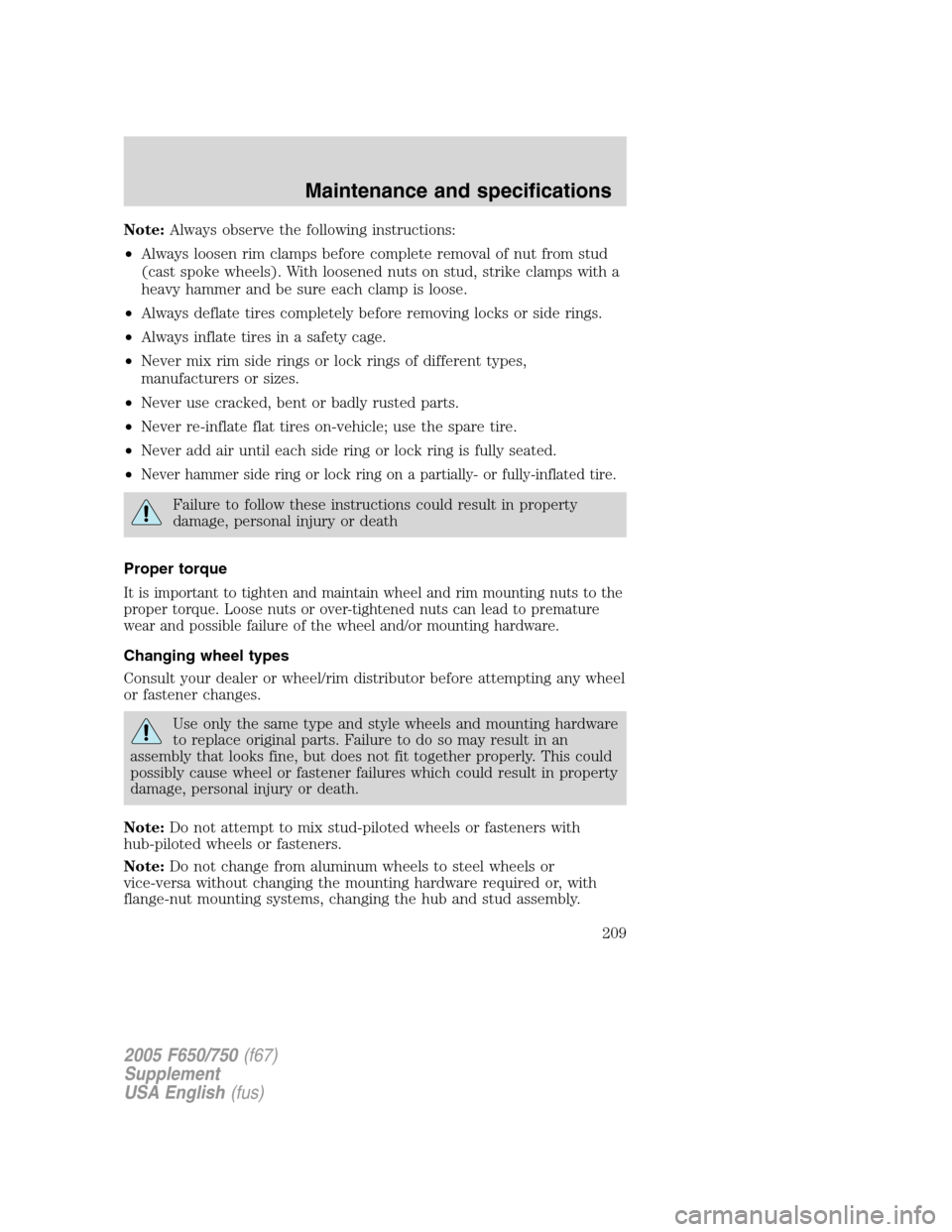
Note:Always observe the following instructions:
•Always loosen rim clamps before complete removal of nut from stud
(cast spoke wheels). With loosened nuts on stud, strike clamps with a
heavy hammer and be sure each clamp is loose.
•Always deflate tires completely before removing locks or side rings.
•Always inflate tires in a safety cage.
•Never mix rim side rings or lock rings of different types,
manufacturers or sizes.
•Never use cracked, bent or badly rusted parts.
•Never re-inflate flat tires on-vehicle; use the spare tire.
•Never add air until each side ring or lock ring is fully seated.
•
Never hammer side ring or lock ring on a partially- or fully-inflated tire.
Failure to follow these instructions could result in property
damage, personal injury or death
Proper torque
It is important to tighten and maintain wheel and rim mounting nuts to the
proper torque. Loose nuts or over-tightened nuts can lead to premature
wear and possible failure of the wheel and/or mounting hardware.
Changing wheel types
Consult your dealer or wheel/rim distributor before attempting any wheel
or fastener changes.
Use only the same type and style wheels and mounting hardware
to replace original parts. Failure to do so may result in an
assembly that looks fine, but does not fit together properly. This could
possibly cause wheel or fastener failures which could result in property
damage, personal injury or death.
Note:Do not attempt to mix stud-piloted wheels or fasteners with
hub-piloted wheels or fasteners.
Note:Do not change from aluminum wheels to steel wheels or
vice-versa without changing the mounting hardware required or, with
flange-nut mounting systems, changing the hub and stud assembly.
2005 F650/750(f67)
Supplement
USA English(fus)
Maintenance and specifications
209
Page 211 of 272
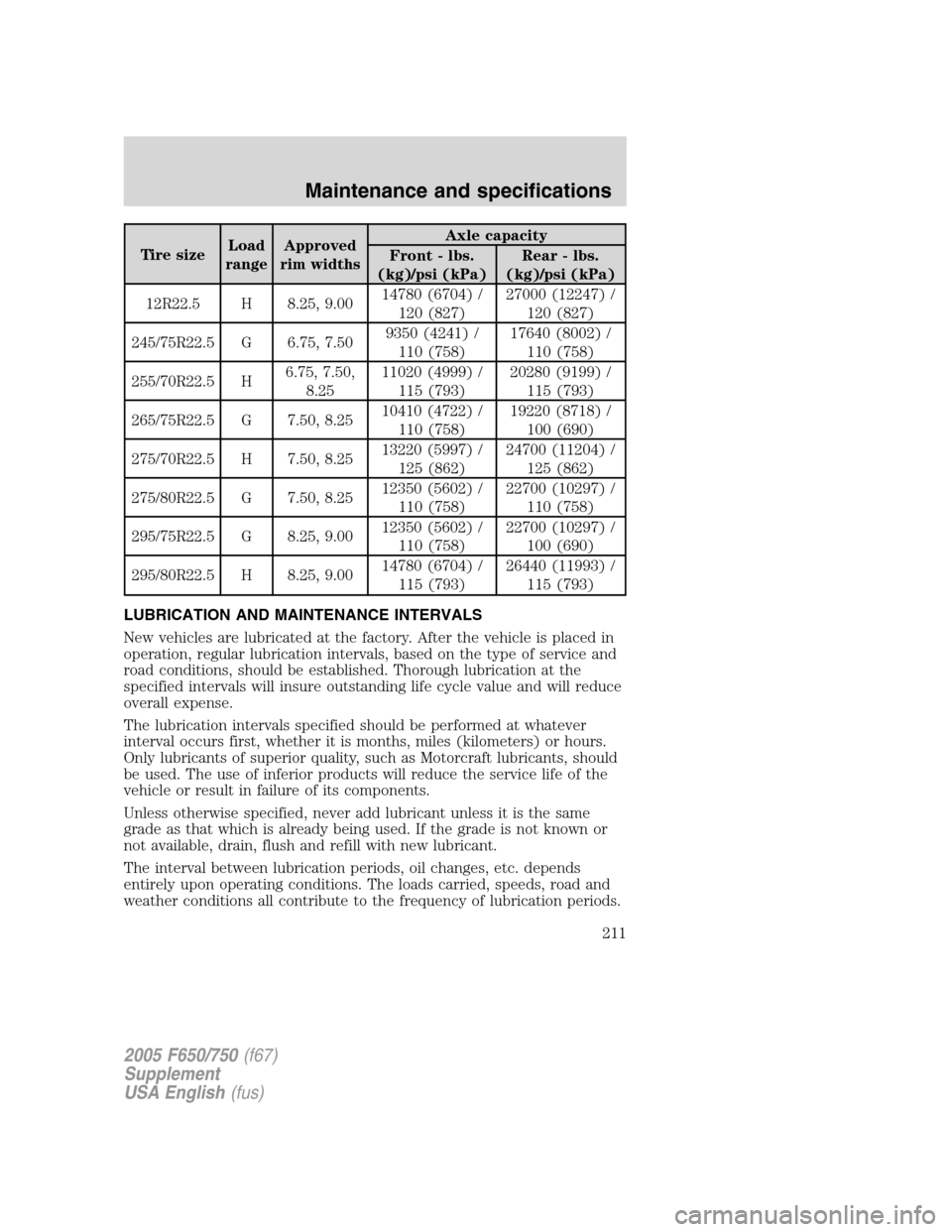
Tire sizeLoad
rangeApproved
rim widthsAxle capacity
Front - lbs.
(kg)/psi (kPa)Rear - lbs.
(kg)/psi (kPa)
12R22.5 H 8.25, 9.0014780 (6704) /
120 (827)27000 (12247) /
120 (827)
245/75R22.5 G 6.75, 7.509350 (4241) /
110 (758)17640 (8002) /
110 (758)
255/70R22.5 H6.75, 7.50,
8.2511020 (4999) /
115 (793)20280 (9199) /
115 (793)
265/75R22.5 G 7.50, 8.2510410 (4722) /
110 (758)19220 (8718) /
100 (690)
275/70R22.5 H 7.50, 8.2513220 (5997) /
125 (862)24700 (11204) /
125 (862)
275/80R22.5 G 7.50, 8.2512350 (5602) /
110 (758)22700 (10297) /
110 (758)
295/75R22.5 G 8.25, 9.0012350 (5602) /
110 (758)22700 (10297) /
100 (690)
295/80R22.5 H 8.25, 9.0014780 (6704) /
115 (793)26440 (11993) /
115 (793)
LUBRICATION AND MAINTENANCE INTERVALS
New vehicles are lubricated at the factory. After the vehicle is placed in
operation, regular lubrication intervals, based on the type of service and
road conditions, should be established. Thorough lubrication at the
specified intervals will insure outstanding life cycle value and will reduce
overall expense.
The lubrication intervals specified should be performed at whatever
interval occurs first, whether it is months, miles (kilometers) or hours.
Only lubricants of superior quality, such as Motorcraft lubricants, should
be used. The use of inferior products will reduce the service life of the
vehicle or result in failure of its components.
Unless otherwise specified, never add lubricant unless it is the same
grade as that which is already being used. If the grade is not known or
not available, drain, flush and refill with new lubricant.
The interval between lubrication periods, oil changes, etc. depends
entirely upon operating conditions. The loads carried, speeds, road and
weather conditions all contribute to the frequency of lubrication periods.
2005 F650/750(f67)
Supplement
USA English(fus)
Maintenance and specifications
211
Page 235 of 272
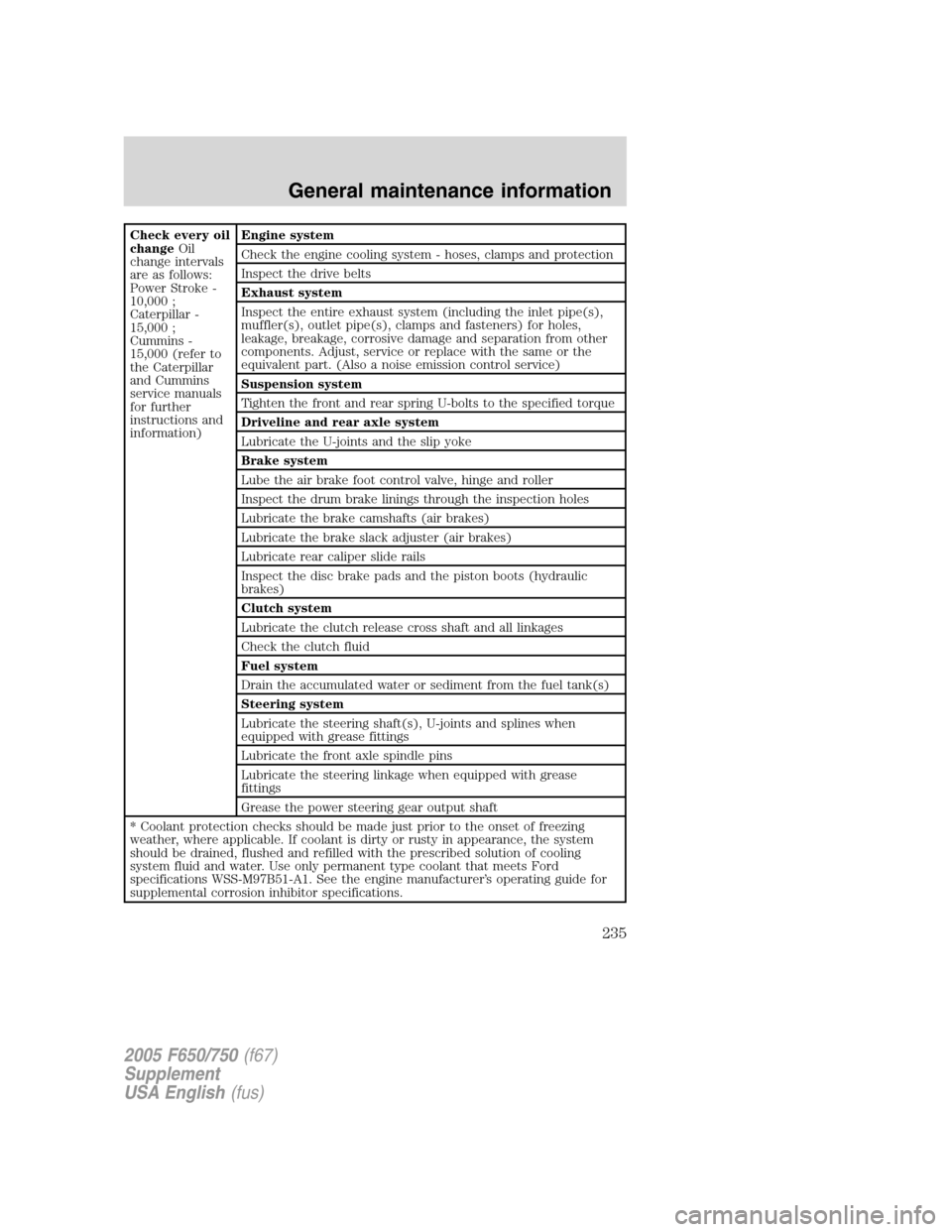
Check every oil
changeOil
change intervals
are as follows:
Power Stroke -
10,000 ;
Caterpillar -
15,000 ;
Cummins -
15,000 (refer to
the Caterpillar
and Cummins
service manuals
for further
instructions and
information)Engine system
Check the engine cooling system - hoses, clamps and protection
Inspect the drive belts
Exhaust system
Inspect the entire exhaust system (including the inlet pipe(s),
muffler(s), outlet pipe(s), clamps and fasteners) for holes,
leakage, breakage, corrosive damage and separation from other
components. Adjust, service or replace with the same or the
equivalent part. (Also a noise emission control service)
Suspension system
Tighten the front and rear spring U-bolts to the specified torque
Driveline and rear axle system
Lubricate the U-joints and the slip yoke
Brake system
Lube the air brake foot control valve, hinge and roller
Inspect the drum brake linings through the inspection holes
Lubricate the brake camshafts (air brakes)
Lubricate the brake slack adjuster (air brakes)
Lubricate rear caliper slide rails
Inspect the disc brake pads and the piston boots (hydraulic
brakes)
Clutch system
Lubricate the clutch release cross shaft and all linkages
Check the clutch fluid
Fuel system
Drain the accumulated water or sediment from the fuel tank(s)
Steering system
Lubricate the steering shaft(s), U-joints and splines when
equipped with grease fittings
Lubricate the front axle spindle pins
Lubricate the steering linkage when equipped with grease
fittings
Grease the power steering gear output shaft
* Coolant protection checks should be made just prior to the onset of freezing
weather, where applicable. If coolant is dirty or rusty in appearance, the system
should be drained, flushed and refilled with the prescribed solution of cooling
system fluid and water. Use only permanent type coolant that meets Ford
specifications WSS-M97B51-A1. See the engine manufacturer’s operating guide for
supplemental corrosion inhibitor specifications.
2005 F650/750(f67)
Supplement
USA English(fus)
General maintenance information
235